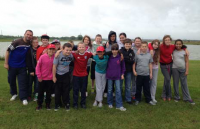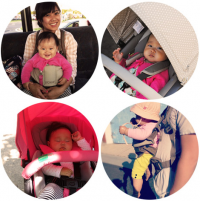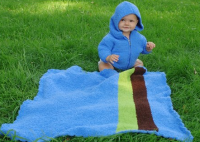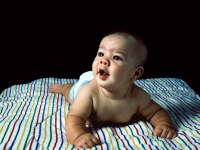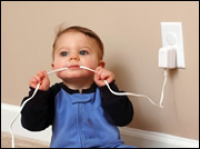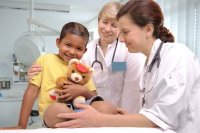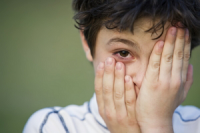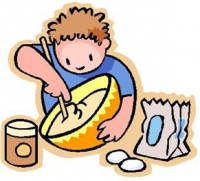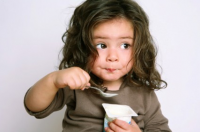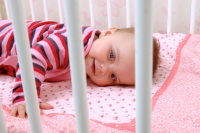Outdoor Games for Primary School Children You are planning an outdoor walk it will have to bear other factors in mind, such as toileting needs, meal times and the weather. If you are planning a walk then make it short and use the elements of nature to keep the children occupied. * For example making a nature trail or treasure hunt for different elements in nature; will make the exercise seem like a fun trip. Younger children also need to be supervised by an adult too. * Adding excitement and interest to the outdoors can work if there is a trip to a nature park or farm, where the animals can provide that interest. Remember to supervise at all times, so safety is a key point to remember. This is are children learn in outdoor games * How to name favourite plants and animals. * Learn about the environment, such as habitats and ecosystems. * Learn about changes in the environment and how it affects people. * Learn about the basic skills for surviving outdoors. * Understanding how to read maps.
Traveling With a Baby Tips Tips Traveling Baby, Traveling Baby Tips Plane, Child Safety, Traveling Baby Care: Being away from home is a big change in routine for both, you and your baby, so you will have to plan ahead, even anticipate problems and be prepared to deal with them, so that the entire family enjoys a good holiday. Taking advice from parents, who have taken their children on holidays, is a good idea. * If you are hiring a car, ask the company to provide you with a baby seat, so that you don't have to carry one. * While booking a holiday, find out what facilities the tour operator provides. Children, who are two years or below, usually travel for free. Your baby will require a passport. * It is easier to travel if you are breast-feeding, you don't have to worry about sterilized bottles or clean water to make bottle-feeds. * Find out what kind of childcare facilities the operator provides, such as baby cots, prams, highchairs etc., so that you do not have to carry these things with you. * Take toys for the journey, old and new ones, so that the baby will be occupied and will not get tired of the journey. * Once you decide on the holiday location, consult your doctor about the vaccination your baby requires before you decide the holiday dates. If there are vaccines to be taken, it is best to take them a little before the holiday date. Some vaccines cannot be taken together and may need a few weeks in between. So, you will need time to vaccinate your baby. * Take your baby sling or back carrier it will occupy less space and it will be easy to carry the baby around. * While booking your holiday, you can book a hotel that provides childcare facilities such as nannies, crèches etc. You should check them before using them and only avail them when you are sure your baby will be well taken care of. * The most difficult part of your holiday will be the journey, and with a small baby, it will not be easy. You should book an air cot well in advance. Get seats that are together, so that you have ample space on the flight. Book meals for your children in advance, it would help if they could be served before you are served. * There could be delays on the way, so you should carry enough snacks for the baby, especially drinks. It is better if the snacks don't consist of sticky food, as they are messy. * If you are holidaying in a place where the weather is hot, make sure that you carry sun block for your baby as his/her skin is delicate and more likely to get sunburns.
Polio Symptoms and Treatment in Babies Polio Symptoms , Polio Treatment, Polio Symptoms Babies: Polio has been wiped out of most countries with only a few developing nations facing its threat now. For this, babies are now being given routinely polio vaccines to ward off any possible threat to their health. However, due to polio being almost eliminated now, most parents often do not realize how important it is to vaccinate their little one against this disease. * Symptoms Given that polio can have life threatening complications, it is surprising to note that most people infected with the disease never realize that they are affected. People suffering from non-paralytic polio or abortive poliomyelitis may reveal the usual symptoms of viral illness like fever, sore throat, headache, vomiting, malaise, back pain, neck pain, pain or stiffness in limbs, muscle spasms and even meningitis. Paralytic polio, which is a more serious but rare form of this disease shows initial symptoms of fever and headache and other signs of non-paralytic polio in the beginning. However, later signs like loss of reflexes, severe muscle aches or spasms, loose and floppy limbs might show up as the infection progresses. Paralysis may hit all of a sudden. * Treatment * Polio is untreatable once infected and hence the prime focus of a treatment is usually aimed on offering comfort, quick recovery and averting further complications. * The patient should be given complete bed rest. * A nutritious diet is strictly advised. * Antibiotics are usually prescribed to deal with secondary infections. * Analgesics are advised to relive pains. * Portable ventilators to help in comfortable breathing. * Physiotherapy to avoid deformity and loss of muscle function.
Indian Baby Care Tips There are various methods that one uses to ensure good health of a child. Given below are the Tips for baby’s good health care. * Make sure that Baby wearing clothes are Dry & deeply cleaned (with Dettol water). * Change nappy or clothes as soon as it gets wet or on Regular basis. * Ensure that the baby’s nails do not grow too long, cut them on regular basis. * Baby massage has been a tradition in Indian society. It is believed that regular massage helps to weight gain, improves body movement and strength of baby. * Before you take your baby for bath, get everything that you need at one place like baby soap, towel, hair oil, powder etc. * Never leave your baby alone in water. * Use only gentle baby soap. * A soft towel or soft cloth should be used to dry your baby. * Bath for a newborn baby is not required on daily basis as their skin is very delicate, Sponge bath is more suitable for a baby. * Be very gentle while bathing your baby. * Your baby could suffer from various skin problems if you do not provide proper protection to the baby skin. Use products that are especially for soft and sensitive baby skin. * Apply soft and gentle soap and shampoos which does not contains hard chemicals & use only branded products. Baby’s skin absorbs lotion easily so avoid strong moisturizers. According to season we should use body lotion (mild) cream for baby skin.
Baby Blanket Ideas Babies give one of the most beautiful sites of nature when they are wrapped in these soft blankets. Blankets for babies are very essential as they protect them from harsh weather and also make way for a cozy sleep. * You can also spread the blanket on the floor to let the baby play freely sitting on it. Blankets can also be used in strollers for the baby to sit or lie cozily. While ransacking a mothering store, you are sure to find multiple blankets, each varying in size, color, texture and pattern. * While selecting a baby blanket, make sure that it is soft lest it causes rashes to your baby. Also, any blanket you choose, it should be cute. What good would be a baby blanket if it’s not super cute and simply adorable! Take a look at the various ideas for baby blanket in the lines below. * Fleece Baby Blanket * Patched Baby Blanket * Stylish Baby Blanket
Meditation for Children Below Eight Years * From the point of view of yogic physiology, children below age eight do not need much formal meditation training. It is more important for these children that their parents learn yoga and meditation and carry yogic principles into their homes . * Children absorb the energy of the environment. If their parents practice some form of self-development, their children will grow up in a healthier, more relaxed and aware environment. * Parents need to practice meditation techniques that increase their own capacity for awareness in the midst of their busy lives, so that they can be more present and available to their children. The child needs to know that a parent is really interested in them, is really listening to and attending to them. At the same time, parents need to learn how to allow children to be themselves and to foster each child's own unique being and abilities. * One meditation technique can be used with children in this age group, however. A modified practice of yoga nidra is a deep relaxation practice in the Corpse Pose (Savasana). In this practice we cannot ask the children to feel individual parts of the body, but rather we work with awareness of larger parts. * For example, we may playfully instruct the child in body awareness by saying, "Feel that you are a statute until I count to 10. Now bend your elbows and now straighten your arms." We give similar instructions with the legs and may ask them to wiggle their toes, and so on. This takes their awareness through the body. * Once children have developed a little body awareness, we can teach them to listen to and follow outside sounds, or to visualize imaginary realms, or we can read stories that stimulate their imaginations.
Antidepressants Bad for Babies The first study, published in Obstetrics and Gynecology, evaluated more than half of a million offspring over 11 years. Of these, just over 1% of the children were exposed to an SSRI during the first trimester of pregnancy. The study provided evidence for a two- to four-fold increased risk of cardiac and neural tube defects with specific SSRIs. Fetal alcohol spectrum disorders were also 10 times more likely in children exposed to an SSRI during pregnancy. * The risk of cardiac abnormalities in children exposed to SSRIs during pregnancy has been shown in many other studies over the last 15 years, with varying degrees of significance. Overall, the absolute risk of abnormalities associated with SSRIs is still very small. Other studies have reported neurobehavioral disorders, bleeding abnormalities, craniosynostosis, and abdominal malformations associated with prenatal SSRI exposure. * The second recent study reported a link between SSRI exposure during pregnancy and an increased risk of autism. This study, published in the Archives of General Psychiatry, found a two- to three-fold increase in autism spectrum disorders among children exposed to SSRIs during pregnancy. * The risk was highest when SSRI exposure occurred during the first trimester of pregnancy. The study cannot prove cause and effect, and a link between a family history of depression and autism has already been established. SSRI exposure may have less to do with the development of autism than the genetic predisposition to depression and autism. * This study was small, and its results should be interpreted cautiously. In both of the recent studies, the authors caution women not to change their mental health treatment plans without speaking to their physician. * In general, it is prudent to avoid unnecessary exposure to medication or other potentially harmful chemicals or products during pregnancy. And, the overall safety profile of SSRIs during pregnancy is questionable. But, SSRIs are also very effective antidepressants. * This class of drugs should not be removed from a mother’s possible treatment options if she requires intervention for prenatal depressive disorders. In other words, don’t throw the proverbial baby out with the bath water. * Studies like the ones published recently might cause unwarranted alarm and prevent mothers from seeking mental health care during pregnancy. Clinicians should be vigilant to confirm a diagnosis of depression during pregnancy and communicate openly with mothers about the benefits, risks, and alternatives of treatment options. Ideally, every pregnancy ends with a healthy baby and a healthy mom. * Mental health is a large piece of the puzzle for new moms and moms-to-be and the physical and psychological risks associated with depression during and after pregnancy might be worse than the risks of congenital malformations or developmental disorders to the fetus.
Chinna Pillalaku Yerpade Pramaadalu చిన్న పిల్లలకు ఏర్పడే ప్రమాదాలు చిన్నపిల్లలు ఉన్న ఇంట్లో పెద్దలు, పిల్లలను ఓ కంటకనిపెడుతూ ఎంతో జాగ్రత్తగా చూసుకోవాలి. ఎందుకంటే చిన్నారులకు అపాయాన్ని గురించి ఆలోచించే వయస్సుండదు. అనుకోకుండా కొన్ని ప్రమాదాలు ఏర్పడితే, మరికొన్నింటిని ప్రమాదమేమో అని తెలియకుండా కొని తెచ్చుకునేవి కొన్ని. పిల్లలకు ప్రమాదం కలిగితే పెద్దలు అతిగాభరా పడుతూ పిల్లల్లో భయాన్ని కలిగించకుండా, వెంటనే ప్రథమచికిత్స పద్ధతులను పాటించాలి. ఆ తర్వాత పిల్లల వైద్యునికి చూపించి, అవసమయితే చికిత్సచేయించాలి. మందులు వాడాలి. అందువల్ల, ఏ ప్రమాదానికి ఏవిధమైన ప్రథమ చికిత్స జరపవలసినదీ పెద్దలకు సరైన అవగాహన ఉండాలి * జారిపడితే : పిల్లలు నేలమీద, మెట్లమీద నుంచి ఎత్తుగా ఉండే అరుగుల మీద నుండి జారిపడి దెబ్బలు తగుల్చుకోవచ్చు. దెబ్బ తగిలిన నొప్పికంటే, భయంతో పిల్లలు ఏడ్చేస్తారు. పిల్లల ఏడుపునకు కంగారు పడకూడదు. పిల్లలను భయపడవద్దని బుజ్జగిస్తూ, ఏం జరిగిందో, ఎక్కడ ఏవిధంగా పడిందీ, దెబ్బ ఎక్కడ తగిలిందీ తెలుసుకోవాలి. చర్మం చీరుకుపోయి రక్తం వస్తుంటే డెట్టాల్ నీటితో చర్మాన్ని శుభ్రంగా కడిగి, టించర్ను దూదితో అద్దాలి. రక్తం ఆగకుండా వస్తుంటే, తడిబట్టతో కొంతసేపు నొక్కి ఉంచాలి. ఆ తర్వాత వైద్యుని వద్దకు తీసుకువెళ్ళి వైద్య సలహా ప్రకారంగా కట్టుకట్టించడమో, మందులు ఇవ్వడమో చేయాలి. * కాలినప్పుడు : చిన్నారులను వేడి వస్తువుల దగ్గరకు రానీయకుండా, వంటింట్లో పరుగులు తీయకుండా చూసుకుంటుండాలి. వేడి నీళ్ళతో ఆడాలని చేయి పెట్టినా చేతులు కాలి, లేత చర్మానికి బొబ్బలొస్తాయి.. వెంటనే పిల్లల చేతులు మీద ధారగా చన్నీళ్ళను పోయాలి. ఆ తర్వాత చల్లని నీళ్ళతో తడిపిన బట్టను చర్మం మీద ఉంచి, వెంటనే డాక్టర్ వద్దకు తీసుకెళ్ళాలి. చిన్నపిల్లలకు అందనంత ఎత్తులో వేడి కుక్కర్ను, వేడి పాత్రలను, బాణలిలాంటి వాటిని ఉంచాలి. డైనింగ్ టేబుల్ మీద, టేబుల్ క్లాత్కు క్రిందకు వేలాడుతున్నట్లుగా వేయకూడదు. చిన్నపిల్లలున్న ఇంట్లో, ఆ టేబుల్ క్లాత్ను పిల్లలు లాగి, టేబుల్ మీద ఉం చిన పాత్రలను, వేడి పదార్థాలను మీద వేసుకునే ప్రమాదం ఉంటుంది. వారి చర్మం కాలే ప్రమాదముంటుంది. పిల్లలకు చర్మంకాలినప్పుడు చర్మం మీద చల్లటి నీటిని ధారగాపోయడమే సరైన పద్ధతి. తేనె పూయడం లాంటివి చేయకూడదు. డాక్టర్కు చూపించాలి. వెంటనే, బొబ్బలను చిదపకూడదు. చర్మాన్ని రబ్చేయకూడదు. * కోసుకుంటే : పెద్దల నిర్లక్ష్యం, అశ్రద్ధ, మతిమరుపు వల్ల కూడా చిన్నారులకు పదునైన వస్తువులు కోసుకునే ప్రమాదం వుంది. కూరలు తరిగే కత్తిపీట, చాకు, కత్తెర, బ్లేడు లాంటి పరికరాలను వాడిన తర్వాత, వాటిని పిల్లలకు అందుబాటులో లేకుండా జాగ్రత్తగా ఉంచాలి పిల్లలు ఆడే ఆట వస్తువుల వల్ల కూడా వారికి చర్మం కోసుకుని లోతుగా దిగే ప్రమాదం ఏర్పడ వచ్చు. పదునుగా వుండే ఆట వస్తు వులు, రేకు లున్న ఇనుప బొమ్మలు, మేకులు, స్క్రూలు లాంటివి ఉన్న బొమ్మలు పిల్లలకు ఆటవస్తువులుగా కొనకూడదు. ఇవ్వకూడదు. గాజు సీసాలు, గాజుపాత్రలు పిల్లలకు అందనంత ఎత్తులో ఉంచాలి. పొరపాటుగా పిల్లలు కోసుకుని నెత్తురు కారుతుంటే, చల్లటి నీటితో తడిపిన బట్టను చుట్టాలి. లేదా ఐస్ ముక్కలను బట్టలో ఉంచి రక్తం కారుతున్న ప్రదేశంలో ఒత్తిపెట్టి ఉంచితే రక్తం కారటం ఆగిపోతుంది. లోతుగా కోసుకుంటే! ఆ భాగాన్ని ఎత్తుగా వుంచి, చల్లటినీటితో తడిసిన బట్టను ఉంచాలి. రక్తస్రావం ఆగిపోయిన తర్వాత, పరిశుభ్రమైన బట్టతో తెగిన ప్రదేశంలో చర్మాన్ని కప్పి, ఒదులుగా చుట్టి, ఆ తర్వాత వైద్యుని వద్దకు తీసుకువెళ్ళి చూపించి, వైద్య సలహా తీసుకోవాలి. అవసరమైన చికిత్సను చేయించాలి. * కీటకాలు కుడితే : కొన్ని రకాల కీటకాలలో కొంత విషపదార్థం ఉంటుంది. అటువంటి విషకీటకాలు కుడితే పిల్లలకు ఎలర్జీ కలిగి, ఆ తర్వాత కుట్టిన చర్మం మీద అమిత బాధకలుగుతుంది. గొంగళి పురుగులు లాంటివి కుడితే, చర్మం మీద పాకితే దురదలు, దద్దుర్లు వచ్చి పిల్లలకు బాధ కలుగుతుంది. అప్పుడు, గోరువెచ్చని నీటితో స్నానం చేయించి, దద్దుర్లు, దురద తగ్గటానికి గొంగళిపురుగు పాకిన ప్రదేశంలో విభూదిని బాగా రుద్దాలి. కొన్ని విషకీటకాలు కుడితే ఎలర్జీ ఏర్పడటమే కాకుండా, మరికొన్ని తీవ్రమైన మార్పులు వస్తాయి. దద్దుర్లు ఎర్రగా మారినప్పుడు, ఊపిరి పీల్చుకోవడంతో ఇబ్బంది కలిగినప్పుడు పెదాలు నల్లబడటం, నాలుక తడారిపోవడం లాంటి లక్షణాలు ఏర్పడితే ఎంతమాత్రం ఆలస్యం చేయకుండా పిల్లలను వైద్యుని వద్దకు తీసుకెళ్ళాలి. అవసరమైన వైద్య సహాయాన్ని పిల్లలకు అందించాలి. * మందులు, రసాయనాలు : మందులు, క్లీనింగ్లోషన్స్ పిల్లలకు అందనంత ఎత్తుగా ఉంచాలి. పిల్లలు ఏమైనా మందులు తాగినా, మందుబిళ్ళలు తిన్నా వాటిని కక్కించాలని, ఉప్పునీళ్ళు త్రాగించడం, మంచినీళ్ళు ఎక్కువగా త్రాగించడం చేయకూడదు. అలా చేసినట్లయితే కడుపులో చేరిన మందులు, వెంటనే రక్తంలో చేరే ప్రమాదం ఉంది. బిడ్డకు ప్రాణాపాయ స్థితి ఏర్పడవచ్చు. ఇటువంటివి జరిగినప్పుడు, తక్షణమే వైద్య సహాయం పొందడం చాల అవసరం. కీటకాలను సంహరించే మందులను అమిత భద్రంగా ఉంచాలి. మందును స్ప్రే చేసినప్పుడు పిల్లలను ఆ ప్రదేశానికి దూరంగా ఉంచాలి. దోమలు, నల్లులు, ఎలుకలు, బొద్దింకలు చీమల సంహారక మందులను పిల్లలు నిద్ర పోయిన తర్వాత ఉపయోగించి, పిల్లలు నిద్రలేవకుండా క్లీన్ చేసేయ్యాలి. వాటిని పిల్లలకు తెలియకుండా దాచాలి. పిల్లలకు ఏర్పడే కొన్ని ప్రమాదాలకు తక్షణ ప్రథమచికిత్స చేయాలి. మరికొన్ని ప్రమాదాలకు ఎంతమాత్రం ఆలస్యం జరగకుండా వైద్య చికిత్స జరగాలి. ముఖ్యంగా, పిల్లలకు ప్రమాదాలు జరిగినప్పుడు పెద్దలు, ఆందో ళన, గాభరా పిల్లల ఎదుట ప్రదర్శించకూడదు. పనులు చేసే టప్పుడు చిన్న పిల్లలున్నారన్న విషయాన్ని దృష్టిలో పెట్టుకుని మరుపు, అ శ్రద్ధ, నిర్లక్ష్యం లేకుండా ప్రవర్తించాలి. పిల్లలకు జరిగే ప్రమాదాలు ప్రాణా పాయ స్థితికి చేరకుండా తక్షణమే, చర్యలు తీసుకోవాలి.
What Parents of Kids Ask a Doctor తల్లిదండ్రులు చిన్న పిల్లల విషయంలో వైద్యులను అడిగే ప్రశ్నలు పిల్లలు చిన్నవాళ్లు. వారి సమస్యలూ చిన్నగానే అనిపిస్తాయి. కానీ ఆలోచింపజేస్తాయి. ఒకసారి ఆలోచిస్తే తీర్చడం సులువే. కనుక వీటి గురించి తెలుసుకుందాం.పిల్లలను తరచుగా పిల్లల డాక్టరు దగ్గరకు తీసుకెళ్తూ వుంటారు. మామూలుగా వచ్చే సమస్యలకు, టీకాలకోసం అది తప్పనిసరి. * పిల్లల్ని పెంచేటప్పుడు అందరికీ అనేక అనుమానాలు, ఆలోచనలు వుంటాయి. వీటిని తీర్చుకోవడం అన్నివిధాలా మంచిది. ఆ అనుమానాల గురించి తల్లిదండ్రులు తమ డాక్టరుతో చర్చించడం ఎంతో అవసరం. అలాగే తెలియని విషయాలు తెలుసుకోవడమూ మంచిదే! * పిల్లల పెరుగుదల భౌతికంగానూ, మానసికంగానూ వుంటుంది. రెంటికీ సరైన పోషణ అవసరం. మానసికంగా ఎదుగుదల అంటే సహజంగా వుండాలి. వారి ఆలోచనలు, అభిప్రాయాలు, వారికంటూ ఒక వ్యక్తిత్వం రూపుదాల్చడానికి ఇవన్నీ అవసరం. వారు ఎదగడంతోపాటూ చుట్టూ వున్న వాతావరణంలోనూ వారు ఇమడగలగాలి. * ఆ విషయాలేంటో పరిశీలిద్దాం.ఎక్కువగా పెద్దల్లో ఈ భయాలు మొదటి సంతానంలో వుంటాయి. రెండోవారికి వచ్చేసరికి పెద్దలకు పూర్తి అవగాహన, అనుభవం ఏర్పడుతుంది. కనుక పెంపకం సులువవుతుంది. తల్లిదండ్రులు వైద్యులను అడిగే అనుమానాలలో కొన్ని... * పండ్లురావడం: జ్వరం, సొల్లుకారడం, చికాకుపడటం, నీళ్ల వీరోచనాలు, మొహం ఎర్రబడటం... ఇవన్నీ పళ్లు కొత్తగా వచ్చేప్పుడు వుంటాయనేది తల్లిదండ్రుల అపోహ. చిన్నపిల్లలకు ఏడాది లోపల సహజంగా వచ్చే జ్వరం, దగ్గు, పడిశం ఆ సమయంలోనూ రావచ్చు. కానీ పళ్లు రావడానికి, జ్వరానికీ సంబంధం లేదు. పండ్లు వచ్చేటపుడు సొల్లుకారడం, పాప చికాకుపడటం ఉండొచ్చు. కానీ పళ్లు రావడానికీ, తక్కిన లక్షణాలకూ సంబంధంలేదు. అది యాదృచ్ఛికం మాత్రమే. జ్వరం వచ్చినా, సరిగా తినకపోయినా వైద్యుని సంప్రదించాలి. * నిద్ర సమస్య: నిద్రసమస్య పసి వయసులో ఎక్కువ. అది తల్లిదండ్రులకు కష్టంగాను, భయంగానూ ఉండొచ్చు. పెరిగే పిల్లల్లో 'నిద్ర' పద్ధతి వయసును బట్టి మారుతుంది. ఉదాహరణకు మొదటి రెండు మూడు నెలల్లో పగలు నిద్రపోయి, రాత్రిపూట మేలుకొని వుంటారు. అలాంటపుడు కంగారుపడకూడదు. రాత్రి పడుకోబోయేముందు కథ చెపుతూనో, కబుర్లతోనో నిద్రపుచ్చడం అవసరం. ఒక బొమ్మను పక్కనుంచడం, నచ్చిన బొమ్మల దుప్పటి కప్పుకోమనడం చేయాలి. ఇవన్నీ వారు క్రమంగా నిద్రలోకి జారుకోవడానికి తోడ్పడతాయి. పక్కనే తల్లిదండ్రులు వున్నారన్న భరోసా వుంటేనే వారు బాగా నిద్రపోతారు.
Child Health Care Tips Here you will find a health care tips for child that will be useful, beneficial, and most importantly give you and your children peace of mind. * Baby Massage : Baby massage is a good old tradition of nurturing the infants, followed by people since centuries. Take few drops of olive oil in your palm and apply it in the circular motion. But be careful your child body is delicate so do not give pressure to your hands while massaging. * Growing Teeth : Make small pieces of potato and cool them in your fridge. Give you child pieces of cold potato and tell him to place them inside his mouth on the tooth that is paining. The cold will sooth the pain. This works well with cucumber too. Find Doctor. * Skin Care : Your baby could suffer from various skin problems if you do not provide proper protection to the baby skin. Use products that are especially for soft and sensitive baby skin. Apply soft and gentle soap and shampoos which does not contains hard chemicals & use only branded products. Baby’s skin absorbs lotion easily so avoid strong moisturizers. According to season you should use body lotion (mild) cream for baby skin. * Bath Time : Before you take your baby for bath, get everything that you need at one place. Never leave your baby alone in water. Use only gentle baby soap. A soft towel or cloth should be used to dry your baby. Sponge bath is more suitable for newborn babies as their skin is very delicate. * Leg Bicycling : Just keep your baby on his back and firmly hold his legs in a half bent position. Next, start moving his legs in a manner, as if he is paddling a bicycle. See that you do it gently. Maintain a steady pace, neither do it too fast, nor make it too slow. This will help in controlling your baby constipation. * Cold Treatment : Use a cool mist humidifier in your infants bedroom. A humidifier adds moisture to the air, which helps ease your baby’s congestion and cough. Use water only. Do not add any oils or medicines to the humidifier unless directed by your pediatrician. * Fever Cure : Take a dry cloth, dip it into the vessel making it completely wet and drain out the excess water. Place it on the baby’s forehead for two minutes and repeat the process. You should be doing this three to four times in a day for at least 20 to 25 minutes. This will help lower the temperature to a great extent. * Earache : Oils can be very soothing to an inflamed eardrum. Place a few drops of olive oil, castor oil or mineral oil into your child’s ear. You can also gently warm the oil first, but be very careful not to make it too hot because that could damage the eardrum.
Storing Breast Milk Tips There are bags that are specially made to store expressed breast milk. You can use small disposable bottle bags or small glass or plastic bottles as well. Depending on how soon you want to use the expressed milk, you can either refrigerate or freeze it. Here are a few tips to follow: * Fresh expressed milk can be stored for ten hours at room temperature. Milk brought to room temperature after refrigerating or freezing must be used within half an hour. * Fresh expressed milk can be refrigerated for anything between five to seven days. Taste the milk to find out whether it is fresh, before giving it to your baby. * You can store freshly expressed milk for up to six months in an average freezer, depending on the efficiency of the freezer. * Make sure you store in the coldest part of the freezer and away from the door. * Pumped milk that has been refrigerated for less than 48 hours can be frozen. If refrigerated for more that 48 hours, it should not be frozen. * Freezing causes breast milk to expand. While filling bottles or bags, leave about one inch from the top, so that there is place to accommodate this expansion. If you are using a disposable bag, fold the top and fasten it with a rubber band. * Milk containers should be labeled with the time and date on which it was expressed. * If you can express large quantities of milk, do not store it in a big bottle or bag. Use small bags or bottles. The baby will need only small quantities at a time and you can defreeze one small bag or bottle each time. Thus, wastage will be minimized. * If you want to transport stored breast milk to use away from home, keep it cold till you use it. Use a cooler with ice or frozen packs to keep the milk cold, while transporting it. * The oldest milk should be used first.
Common Heart Problems in Children Two common congenital heart diseases are atrial septal defect and ventricular septal defect. In atrial septal defect, there is a hole between the two atria of the heart. In ventricular septal defect, there is a hole between the two ventricles. These holes cause oxygenated blood to move from the left side of the heart to the right side and then to the lungs. * This can lead to accumulation of blood in the lungs and heart failure if the hole is big. If the hole is small, a child may experience no symptoms. Despite this fact, the Cincinnati Children's Heart Institute advises that children with small holes in the heart should be monitored by a cardiologist. * Some children are born with heart problems like pulmonary valvular stenosis and coarctation the the aorta. These conditions obstruct the flow of blood through the heart. Normally blood flows from the right ventricle into the lungs through the pulmonary artery. There is a valve between the right ventricle and pulmonary artery. When this valve is stenosed, or narrow, blood isn't able to move freely to the lungs. * This condition is known as pulmonary valvular stenosis, and it can lead to low blood oxygen levels, along with fatigue. The aorta supplies oxygenated blood to every part of the body. In coarctation of the aorta, part of the aorta is narrow, which prevents free blood flow. It can also lead to low oxygen in the blood. * Children acquire heart diseases due to factors like infection and for also unknown reasons. Kawasaki disease and rheumatic fever are the two major causes of acquired heart disease in children living in the United States, notes the American Heart Association. The cause of Kawasaki disease is unknown, but it typically affects children younger than five years and occurs more frequently in boys. * It causes inflammation of the heart and damages the coronary arteries and heart valves. Kawasaki disease can lead to a heart attack. Rheumatic heart disease is caused by a throat infection and leads to damaged heart valves. It usually occurs in children between five and 15 years old.
Healthy After School Snacks If your kids are participating in a qualifying program at their school, then they are receiving snacks that adhere to these guidelines.Healthy snacking not only satisfies hunger between meals, it can improve concentration during homework or extracurricular activities, and prevent overeating at meal time. * Mini bagels with cream cheese and sliced cucumbers * Hummus dip with pita, crackers or veggies * Sliced avocados with wheat crackers * Celery filled with cream cheese, Boursin cheese, or peanut butter * Edamame in the shell, sprinkled lightly with sea salt * Chickpeas or other beans, eaten with fingers or toothpicks * Olives, pickles, canned artichokes or hearts of palm * Fruit Kabobs (Cut fruit on a stick and dipped in vanilla yogurt) * Smoothies: combine fresh and/or frozen fruit, fruit juice and yogurt or soy milk * Dried fruit such as mango, apricots, raisins, plums * Ice cream cone or waffle bowl filled with yogurt and chopped fruit
Concentration is Good Meditation For Kids (ఏకాగ్రతే పిల్లలకి చక్కటి మెడిటేషన్ ) Concentration Meditation Kids, Concentration Meditation, Best Meditation Techniques Children, Children Meditation: బాల్యం అంటేనే ఒకలాంటి చాపల్యాని స్ఫురింపజేస్తుంది. కన్పించే వాటన్నింటి అంతు చూడాలన్న ఆత్రుత కుతూహలం వారిని ఒక విషయంపై దృష్టి కేంద్రీకరించనీయవు. కానీ స్కూల్లో చేరి, పాఠాలు చదువుకోవడం మొదలెట్టినా పిల్లలు ఏకాగ్రతను అలవరచుకోక పోవడం పెద్దలను బాధిస్తూనే ఉంటుంది. ఆరేడేళ్ళ పిల్లల గురించి పాఠశాలలో టీచర్లు, ఇంట్లో తల్లిదండ్రులు తరచూ చేసే ఫిర్యాదు ఎక్కడా క్షణం కుదురుగా కూర్చోడు, పది నిముషాలైన పుస్తకం పట్టుకొని చదవడు అని. * ఏకాగ్రతతో దృష్టిని నిలపడం నిజానికి పిల్లలకు చాలా కష్టమైన పనే. కొంతమందికి స్వతహాగా ఉంటే, కొంతమందికి పెద్దల భయంతో బలవంతాన అలవర్చుకుంటారు. అలా కాకుండా పిల్లలు ఇబ్బంది పడకుండా వారికీ అలవాటయ్యేలా చెయ్యాలంటే పెద్దలు కాస్త శ్రమపడాల్సి ఉంటుంది. * బాబు గానీ, పాపా కానీ ఏదైనా ఒక పనిలో లీనమవడం పెద్దలు గమనిస్తే వాళ్ళను డిస్టర్బ్ చేయకుండా కొనసాగనివ్వాలి. * వారి ధ్యాస మళ్లించే ప్రయత్నాలేవీ చేయకూడదు. * వాళ్ళు చెప్పిన పనిని మెచ్చుకుంటూ దానిని ఇంకా కొనసాగించేలా ప్రోత్సహించాలి. * వాళ్ళ పక్కనే మీరూ నిలబడి సహాయపడటమో, మరో పని చేస్తూనో వారిని గమనిస్తుండాలి. మధ్య మధ్యలో ప్రశంసలు, చిన్న సూచనలు ఇవ్వచ్చు. ఇలా చేయడం వల్ల మీరున్నంతసేపో అ పని చేసి ఒక పనిపై ఎక్కువ సమయం గడిపినవరవుతారు. పిల్లలకు ఇదే క్రమేపి ఏకాగ్రత పెరగడానికి దోహదం చేస్తుంది. * పిల్లలు చేయాల్సిన పనులను వారికి ఆసక్తికరంగా ఉండేలా మార్చండి. ఈ రోజు ఇంగ్లీష్ పాఠం పూర్తిగా రెండు సార్లు చదివితే కథ చెప్తానని, తెలుగు హోం వర్క్ నీట్ గా రాస్తే పాట నేర్పుతానని- ఇలా వర్క్ ఆసక్తి కలిగే విషయాలను చెప్పాలి. పాఠమంతా చదివాక ఫలానా పదం ఎన్నో లైనులో ఉందో చూసి చెప్పు. ఈ పదం స్పెల్లింగ్ నేను చెప్తాను కరేక్టేనేమో నువ్వు చూడు... ఇలా చిన్న చిన్న ఆటలు, మాటలతో వారు ఎక్కువసేపు ఇక పనిలో కొనసాగేలా చేయవచ్చు. అయితే రోజూ కొంచెం చొప్పున సమయం పెంచుకుంటూ వెళ్ళాలి. కానీ ఒకే రోజు గంటసేపు కుర్చోబెట్టకూడదు. * పిల్లలు ఎక్కువగా ఇష్టపడేది కార్టూన్ ఛానల్ చూడడం. వారిని రోజులో కొంత సమయం వారికి నచ్చిన ఛానల్ ని చూడనివ్వడం.దాని వాళ్ళ పిల్లలో కొంచెం స్ట్రెస్ తగ్గుతుంది. * హాలిడేస్ లో వారికీ నచ్చిన ప్రదేశానికి, ఆట స్థలాల్ని తీసుకెళ్ళాలి. * మొత్తం చదువుపైననే కాకుండా వారికీ అన్ని ఆటలు నేర్పించాలి. * పిల్లలకి పెట్టే ఆహారపదార్థాల విషయంలో చాలా జాగ్రతాలు తీసుకోవాలి. వారికి ఇష్టంలేని పదార్థాలు లంచ్ బాక్స్ లో పెట్టడం వల్ల పిల్లలు సరిగా తినరు. ఖాళీ కడుపుతో ఉంటే టీచర్లు చెప్పే పాఠాలు బుర్రకెక్కవు. * పిల్లలకి ఎక్కువ మార్కులు వచ్చినప్పుడు మెచ్చుకోవడం తక్కువ మార్కులు వచ్చినప్పుడు తిట్టడం లాంటివి చేయకూడదు. తక్కువ మార్కులు వచ్చినప్పుడు వారికి చదువుపై శ్రద్ధ పెరిగే విధంగా మసలుకోవాలి. నమ్రతగా వారికి నచ్చ చెప్పాలి. * ఇలా పిల్లల్లో ఏకాగ్రత పెరిగే విధంగా తల్లిదండ్రులు చిన్న చిన్న సూచనలు పాటిస్తే సరిపోతుంది. అదే వారి బంగారు భవిష్యత్తుకు చక్కటి బాట వేస్తుంది. పిల్లల్లో ఏకాగ్రత పెంచితే చాలు అదే మంచి మెడిటేషన్.
Cell Phone Problems in Children Cell Phone Problems Children, Children Cell Behavioral Problems, Cell Phone Problems Kids, Children's Health and Cell Phones.
Food Allergies in Children Food allergy refers to an abnormal reaction of body towards a certain food. Food allergies in children are most often seen under the age of four. Some of the common allergy rendering foods are. • Fish • Eggs • Milk • Nuts • Tomatoes • Citrus Fruits
Baby Crib Safety Tips There are only a few basic safety measures that are to be followed to ensure a safe and comfortable sleep for your baby. * Check the bedding on the crib. The sheet should have a smoothed, firm fit. Use only sheets for bedding, even though bumper pads are adorable, they are not recommended for baby crib safety. Loose fitting bumper pads attached only by the ends allow a baby’s head to get between the pads and the rails. * Place the baby on his/her back in a crib with a firm tight-fitting mattress. Avoid putting pillows, quilts, comforters or pillow-like stuffed toys in the crib. Use only fitted bottom sheet, specially made for crib use. * Use a sleeper instead of a blanket. Sleeper will keep the baby safe and comfortable. If at all you use a blanket, cover the baby from foot to chest only. This will not suffocate the baby. Cover the sides of the crib with a thin blanket. * Remove all the objects from a baby’s crib. Place a baby mobile phone for them to play with. This will help them keep busy and not looking for any other toys. Remove even any extra diapers or wipes kept at the end of the crib. It may not look dangerous, but it is better to be safe. * There should not be much gap between the crib slats, so that a baby’s body cannot fit through the slats. There should also not be any missing or cracked slats. The corners should be 1/16th inch high so that a baby’s clothes do not get trapped. For mesh-sided cribs, look for mesh less than ¼ inches in size. Mesh should not be torn, or with holes or loose threads. Mesh should also be attached to the top rail and floor plate properly. * Check the railings and the drop-side of the cribs. The railings should be checked properly, irrespective of the crib being old or new. It is mandatory for the crib’s safety. Rails on a used baby crib should be checked for stability. * Latch properly the drop down side of the crib and then use pressure and check that it doesn’t come down on its own. Then, check for loose screws and latches. Tighten them if required. * Cribs that are assembled wrong, or have missing screws or broken latches or any other hardware can lead to suffocation or entrapment. Infants can strangle themselves when their head and neck gets entrapped in the gaps. Make sure there are no missing hardware, screws, slats or mesh in the crib. The crib should just be intact for the safety of the kid.

